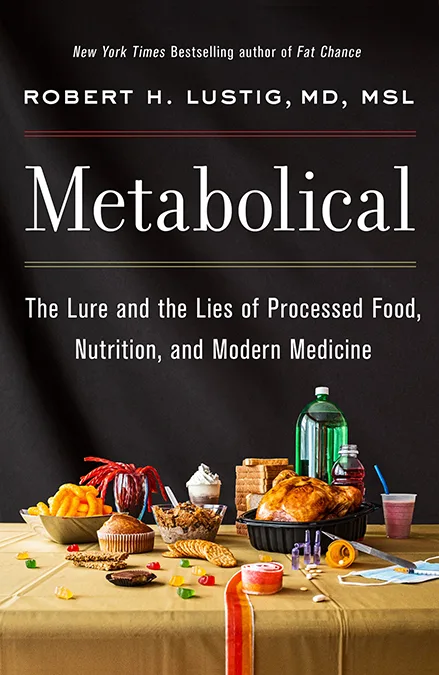Not your Grandma’s Nutraceutical
God gave you a red Corvette with no owner’s manual
Metabolical - your owner’s manual

And that’s what my book Metabolical is about. I’m going to recite the 8 steps on how you’re going to maintain that Corvette. And then we’re going to talk about the mitochondria.
- Glycation – the binding of glucose or fructose to any protein – which reduces protein flexibility and reduces protein capability.
- It also releases Reactive Oxygen Species (ROS) – that’s what causes rusting of your body, of your chassis, of your cells.
- Mitochondrial dysfunction itself.
- Insulin resistance – when your insulin doesn’t do its job… fixing the liver is job one.
- Membrane stability – that’s where omega threes come in.
- Inflammation. Where does inflammation come from? In some people it’s going to be autoimmune disease, but in others the primary source of inflammation is the gut. So when your gut works right, your inflammation is low and when your gut works wrong, you have leaky gut and basically all the junk gets into your bloodstream, and you’re going to set off inflammation throughout the body.
- Methylation – putting methyl groups in various places stops various genes from working, which is a big problem.
- Autophagy – garbage night for the cell. The cell makes all sorts of junk and the junk has to get cleaned out. And that’s what sleep is – garbage night for the brain, taking all the junk that is accumulated. Most of that junk is a byproduct of mitochondrial metabolism.
So of those 8, how many of those have a drug that works on them? None.
We have drugs that treat symptoms of disease like
- Statins will lower LDL.
- Oral hypoglycemics will lower blood glucose. So what?
- Antihypertensives will lower blood pressure? That’s not the problem. You have to actually treat the problem to fix the problem.
You can’t treat the symptom and then expect the problem to be fixed. And that’s what modern medicine has been doing for chronic disease for the past 50 years. It has ignored the pathogenesis of the disease in order to treat the symptomatology. It’s like giving an aspirin to a patient with a brain tumor because they have a headache. It might help the headache, but it isn’t going to do a damn thing for the brain tumor, but that’s what we’re doing.
Now, of those 8 pathologies, none of them have a drug, but they all have food. Every one of those 8 pathologies is responsive to food.
- Glycation is responsive to changes in glucose, fructose
- oxidative stress – fructose and trans fats.
- Mitochondrial dysfunction, all the things we’re talking about
- Insulin resistance – glucose, fructose and branched chain amino acids
- Membrane stability – omega threes
- Inflammation – fructose, gluten and other things that different people may be allergic to
- Methylation – vitamin B6, B12 and folate
- Autophagy – either intermittent fasting or frequent feeding
Food fixes all 8, and there’s no medication that fixes any of the 8. Food rules. The problem is our food sucks and it’s not getting better. And what it’s leading to is a reduction in mitochondrial ATP production because there’s stuff in our environment that is causing mitochondria to be dysfunctional
- Ionizing radiation
- Air pollution
- Microplastics
- Other chemicals in the environment, water, air, and, especially. in the food.
And the one that is the big kahuna, that is about 80% of this is fructose, because it’s in everything and it’s been put in everything by the food industry for its purposes, not for yours. And, if we got rid of it, it would probably solve, or might not solve the obesity epidemic completely. But there’s no doubt in my mind it would solve the metabolic syndrome epidemic — all the diseases that go along with obesity that are not obesity itself.
In order to do that, we have to make the mitochondria work better. Period.
Our mitochondria are screwed… So the question is how to boost mitochondrial capacity? Well, the obvious is to eat better.
How’s that working for you?
We got a whole lot of people bankrupting the health care system who are not doing it.
So how to boost mitochondrial ATP output? That’s where BlueOakNx comes in.
Blue Oak Nutraceuticals - Not Your Grandma's Nutraceutical
And that’s why I’m very happy to be here. I’m very happy to be an advisor to this company, stand up here and put my reputation on the line for something I actually believe in…
We have a saying at UCSF in God We Trust, everybody else has to produce the data. Sundeep produced the data, and the data is pretty remarkable in terms of how it works!

Everybody knows ATP synthase, the enzyme that makes ATP, is a molecular motor. It spins both directions. When it spins clockwise, you make ATP. When you spin counterclockwise, you use up ATP. So you want to keep it in the clockwise direction.
Well, there’s a protein that sits on that ATP synthase locking it in place. And (-)-Epicatechin is the key that basically enacts that lock. Cool! So when you add (-)-Epicatechin to cells, to mice, to animals, to humans, you get increased ATP generation, which is fantastic.
But here’s the thing, there’s a lot of (-)-Epicatechin out there on the market. You can go buy it for a whole lot cheaper.
What's different about the Blue Oak Nutraceuticals Supplement?
When you extract the (-)-Epicatechin from green tea and other sources, you’re not just getting the (-)-Epicatechin, you’re getting the isomers, you’re getting the stereo isomers, you’re getting the enantiomers, you’re getting the things that are mirror images and they will actually block up that binding site. And so it reduces the potency, it reduces the capability. And that’s why the data on green tea is kind of salutary – it’s not that good, yet people swear by it. But in fact, when you actually look at the clinical studies, not so much.
These [BlueOakNX] studies are damn good. And the reason is because Sundeep has figured out a way to separate the two, to get the racemic mixture separated so that only the active (-)-Epicatechin is being utilized in this box here.
That’s why this is so cool. So that’s why we have such really good double blind placebo controlled data.
But there's something else.
I’m an endocrinologist. Any nutritionist, any physiologist, any dietitian, any general medicine physician, would be interested in this. Why do you need an endocrinologist?
Well, Sundeep is a biochemist, par excellence, biochemist extraordinaire. And he looked at (-)-Epicatechin and he looked at what it looked like in terms of molecular modeling. And it turns out that it looks like a steroid, which comes from the adrenal gland – a very specific steroid. But this steroid turns out to be present in our adrenals, and it goes down with aging. And this steroid works on ATP synthase at femtomolar levels – which means it is a physiologic process.
I think that Sundeep has actually unlocked a key component of the aging process and one of the reasons why chronic disease occurs in the aging process.
This is not a little thing.
This is a friggin’ big thing as far as I’m concerned. If it pans out, it’s actually a Nobel Prize that we will see.
The point is that this is not your grandma’s nutraceutical. This is very special. And, I would not be here talking about it. I would not have invited all of my colleagues and friends to be here if I didn’t think this was actually something very important, very new, very special and very relevant to health in this country.
Watch the video.



